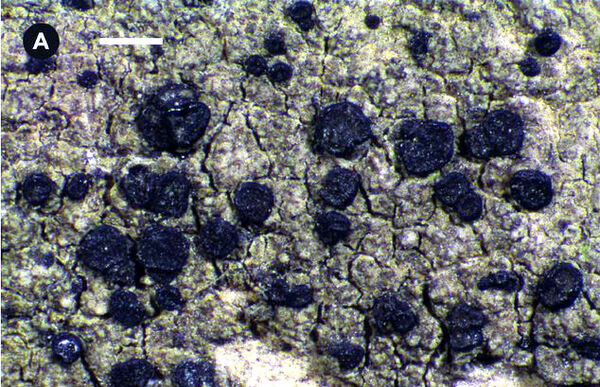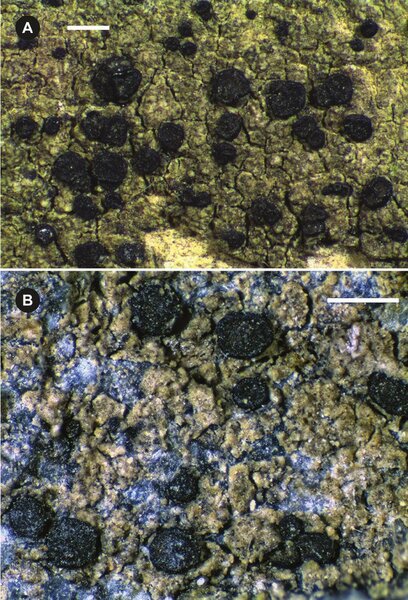Bacidia notarisiana (A. Massal.) Zahlbr.
Cat. Lich. Univ., 4: 131, 1926. Basionym: Bilimbia notarisiana A. Massal. - Framm. Lichenogr.: 21, 1855.
Synonyms:
Distribution: N - Frl (Ekman 2014), Emil (Fariselli & al. 2020), Lig (Lazzarin 2000b, Ekman 2014).
Description: Thallus crustose, thinly episubstratic, pale green to grey-green, finely warted-areolate. Apothecia lecideine, 0.2-0.5 mm across, round to irregular in outline, with a flat to convex, epruinose, beige-brown to black, often piebald disc, and a concolorous or darker, often shiny, finally sometimes excluded proper margin. Proper exciple 34-60 μm thick, without crystals, dark red-brown or blackish green, with a mixture of a red-brown (K+ purplish, N+ orange-red) and a sordid green pigment (K+ intensifying green, N+ purple, with the precipitation of blue crystals), consisting of radiating hyphae with thick gelatinous walls, the terminal cells up to 5 μm wide; hymenium 45-65 μm high, colourless in lower part, the upper part with varying amounts of a green pigment often concentrated into vertical streaks; paraphyses abundant, 1.2-1.7 μm thick at mid-level, simple or sparingly branched in upper part, rarely anastomosing, the apical cells to 4.7 μm wide; hypothecium coloured like the exciple, but much paler. Asci 8-spored, clavate to cylindrical-clavate, the apical dome K/I+ dark blue with a pale, conical-pointed apical cushion (axial mass), the wall K/I-, but the thin outer gel K/I+ blue, Bacidia-type. Ascospores 3-septate, hyaline, short-bacilliform to fusiform, straight or slightly curved, 11-19 x 2.5-4 μm. Pycnidia semi-immersed, the wall with a red-brown (K+ purplish, N+ orange-red) pigment around the ostiole. Conidia simple, more or less curved, 8-16 x c. 1 μm, the cells 5-12 μm in diam. Photobiont chlorococcoid. Spot tests: thallus K-, C-, KC-, P-. Chemistry: thallus without lichen substances.
Note: on calcareous rocks, sometimes in anthropogenic settings (e.g. on mortar and concrete); currently known only from low or moderate elevations in Northern Italy, but likely to be more widespread in the Mediterranean Region (see Ekman 2014).
Growth form: Crustose
Substrata: rocks
Photobiont: green algae other than Trentepohlia
Reproductive strategy: mainly sexual
Commonnes-rarity: (info)
Alpine belt: absent
Subalpine belt: absent
Oromediterranean belt: absent
Montane belt: absent
Submediterranean belt: rare
Padanian area: extremely rare
Humid submediterranean belt: rare
Humid mediterranean belt: very rare
Dry mediterranean belt: absent

Predictive model
Herbarium samples
Growth form: Crustose
Substrata: rocks
Photobiont: green algae other than Trentepohlia
Reproductive strategy: mainly sexual
Commonnes-rarity: (info)
Alpine belt: absent
Subalpine belt: absent
Oromediterranean belt: absent
Montane belt: absent
Submediterranean belt: rare
Padanian area: extremely rare
Humid submediterranean belt: rare
Humid mediterranean belt: very rare
Dry mediterranean belt: absent

Predictive model
| Herbarium samples |
 INDEX FUNGORUM
INDEX FUNGORUM
 GBIF
GBIF
 DOLICHENS
DOLICHENS



